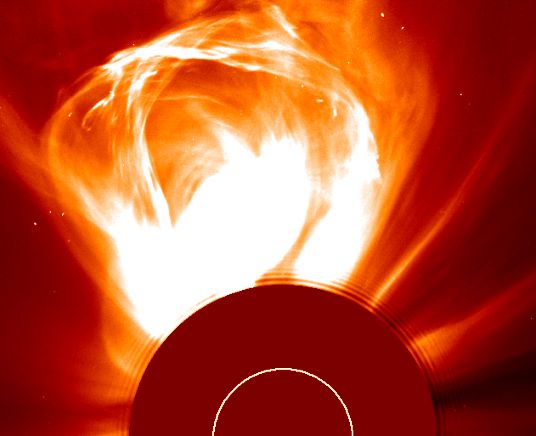Explanation: Late last month another erupting filament lifted off the active solar surface and blasted this enormous bubble of magnetic plasma into space. Direct light from the sun is blocked in this picture of the event with the sun's relative position and size indicated by a white half circle at bottom center. The field of view extends 2 million kilometers or more from the solar surface. While hints of these explosive events, called coronal mass ejections or CMEs, were discovered by spacecraft in the early 70s this dramatic image is part of a detailed record of this CME's development from the presently operating SOlar and Heliospheric Observatory (SOHO) spacecraft. Near the minimum of the solar activity cycle CMEs occur about once a week, but as we approach solar maximum rates of two or more per day are anticipated. Though this CME was clearly not headed for Earth, strong CMEs are seen to profoundly influence space weather, and those directed toward our planet and can have serious effects.
1999 2000 2001 2002 2003 2004 2005 2006 2007 2008 2009 2010 2011 2012 2013 2014 2015 2016 2017 2018 2019 2020 2021 2022 2023 2024 2025 |
Январь Февраль Март Апрель Май Июнь Июль Август Сентябрь Октябрь Ноябрь Декабрь |
NASA Web Site Statements, Warnings, and Disclaimers
NASA Official: Jay Norris. Specific rights apply.
A service of: LHEA at NASA / GSFC
& Michigan Tech. U.
|
Публикации с ключевыми словами:
Sun - storm - coronal mass ejection - eruptive prominence - Протуберанец - корональный выброс - Солнечная активность
Публикации со словами: Sun - storm - coronal mass ejection - eruptive prominence - Протуберанец - корональный выброс - Солнечная активность | |
См. также:
Все публикации на ту же тему >> | |
